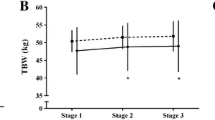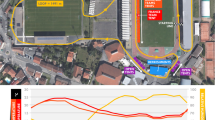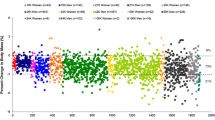Abstract
Background
Loss of body mass during a 24-h run was considered to be a result of dehydration.
Aims
We intended to quantify the decrease in body mass as a loss in fat mass or skeletal muscle mass and to quantify the change in hydration status.
Methods
Body mass, fat mass, skeletal muscle mass, haematocrit, plasma sodium and urinary specific gravity were measured in 15 ultra-marathoners in a 24-h run.
Results
Body mass decreased by 2.2 kg (p = 0.0009) and fat mass decreased by 0.5 kg (p = 0.0084). The decrease in body mass correlated to the decrease in fat mass (r = 0.72, p = 0.0024). Urinary specific gravity increased from 1.012 to 1.022 g/mL (p = 0.0005).
Conclusions
The decrease in body mass and the increase in urinary specific gravity indicate dehydration. The decrease in body mass was correlated to the decrease in fat mass and therefore not only due to dehydration.


Similar content being viewed by others
References
Pastene J, Germain M, Allevard AM, Gharib C, Lacour JR (1996) Water balance during and after marathon running. Eur J Appl Physiol 173:49–55
Whiting PH, Maughan RJ, Miller JD (1984) Dehydration and serum biochemical changes in marathon runners. Eur J Appl Physiol 52:183–187
Kao WF, Shyu CL, Yang XW et al (2008) Athletic performance and serial weight changes during 12- and 24-hour ultra-marathons. Clin J Sport Med 18:155–158
Fellmann N, Bedu M, Giry J et al (1989) Hormonal, fluid, and electrolyte changes during a 72-h recovery from a 24-h endurance run. Int J Sports Med 10:406–412
Knechtle B, Wirth A, Knechtle P, Rosemann T (2009) An ultra-cycling race leads to no decrease in skeletal muscle mass. Int J Sports Med 30:163–167
Knechtle B, Duff B, Amtmann G, Kohler G (2008) An ultra-triathlon leads to a decrease of body fat and skeletal muscle mass—the Triple Iron Triathlon Austria 2006. Res Sports Med 16:97–110
Knechtle B, Kohler G (2007) Running 338 km within 5 days has no effect on body mass and body fat but reduces skeletal muscle mass—the Isarrun 2006. J Sports Sci Med 6:401–407
Kavouras SA (2002) Assessing hydration status. Curr Opin Clin Nutr Metab Care 5:519–524
Shireffs SM (2003) Markers of hydration status. Eur J Clin Nutr 57:S6–S9
Armstrong LE (2007) Assessing hydration status: the elusive gold standard. J Am Coll Nutr 26:575S–584S
Armstrong LE, Maresh CM, Castellani JW et al (1994) Urinary indices of hydration status. Int J Sport Nutr 4:265–279
Armstrong LE, Soto JA, Hacker FT Jr, Casa DJ, Kavouras SA, Maresh CM (1998) Urinary indices during dehydration, exercise, and rehydration. Int J Sport Nutr 8:345–355
Almond CS, Shin AY, Fortescue EB et al (2005) Hyponatremia among runners in the Boston Marathon. N Engl J Med 352:1550–1556
Irving RA, Noakes TD, Buck R et al (1991) Evaluation of renal function and fluid homeostasis during recovery from exercise-induced hyponatremia. J Appl Physiol 70:342–348
Stumpfle KJ, Lehmann DR, Case HS, Hughes SL, Evans D (2003) Change in serum sodium concentration during a cold weather ultradistance race. Clin J Sport Med 13:171–175
Noakes TD, Sharwood K, Speedy D et al (2005) Three independent biological mechanisms cause exercise-associated hyponatremia: evidence from 2,135 weighed competitive athletic performances. Proc Natl Acad Sci USA 102:18550–18555
Speedy DB, Faris JG, Hamlin M, Gallagher PG, Campbell RG (1997) Hyponatremia and weight changes in an ultradistance triathlon. Clin J Sport Med 7:180–184
Hew TD (2005) Women hydrate more than men during a marathon race: hyponatremia in the Houston marathon: a report on 60 cases. Clin J Sport Med 15:148–153
Speedy DB, Noakes TD, Kimber NE et al (2001) Fluid balance during and after an Ironman triathlon. Clin J Sport Med 11:44–50
Chorley J, Cianca J, Divine J (2007) Risk factors for exercise-associated hyponatremia in non-elite marathon runners. Clin J Sport Med 17:471–477
Knechtle B, Duff B, Schulze I, Rosemann T, Senn O (2009) Anthropometry and pre race experience of finishers and non-finishers in a multi-stage ultra-endurance run—Deutschlandlauf 2007. Percept Mot Skills 109:105–118
Knechtle B, Duff B, Schulze I, Kohler G (2008) A multi-stage ultra-endurance run over 1,200 km leads to a continuous accumulation of total body water. J Sport Sci Med 7:357–364
Lee RC, Wang Z, Heo M, Ross R, Janssen I, Heymsfield SB (2000) Total-body skeletal muscle mass: development and cross-validation of anthropometric prediction models. Am J Clin Nutr 72:796–803
Ball SD, Altena TS, Swan PD (2004) Comparison of anthropometry to DXA: a new prediction equation for men. Eur J Clin Nutr 58:1525–1531
van Beaumont W (1972) Evaluation of hemoconcentration from hematocrit measurements. J Appl Physiol 31:712–713
ASCM (1995) Guidelines for exercise testing and prescription, 3rd edn. Williams and Wilkins, Philadelphia, PA, pp 277
Noakes T (2002) Hyponatremia in distance runners: fluid and sodium balance during exercise. Curr Sports Med Rep 1:197–207
Noakes TD, Sharwood K, Collins M, Perkins DR (2004) The dipsomania of great distance: water intoxication in an Ironman triathlete. Br J Sports Med 38:E16
Kaminsky LA, Paul GL (1991) Fluid intake during an ultramarathon running race: relationship to plasma volume and serum sodium and potassium. J Sports Med Phys Fitness 31:417–419
Knechtle B, Schwanke M, Knechtle P, Kohler G (2008) Decrease in body fat during an ultra-endurance triathlon is associated with race intensity. Br J Sports Med 42:609–613
Kovacs EM, Senden JM, Brouns F (1999) Urine color, osmolality and specific electrical conductance are not accurate measures of hydration status during postexercise rehydration. J Sports Med Phys Fitness 39:47–53
Popowski LA, Oppliger RA, Patrick Lambert G, Johnson RF, Kim Johnson A, Gisolf CV (2001) Blood and urinary measures of hydration status during progressive acute dehydration. Med Sci Sports Exerc 33:747–753
Knechtle B, Wirth A, Knechtle P, Rosemann T (2009) Increase of total body water with decrease of body mass while running 100 km nonstop—formation of edema? Res Q Exerc Sport 80:593–603
Acknowledgments
We thank the crew of ‘Sri Chinmoy Marathon Team Switzerland’ for their generous support and the athletes for their promptitude to collect data during the race. For their help in translation, we thank Matthias Knechtle, Lausanne, Switzerland, and Mary Miller from Stockton-on-Tees, Cleveland in England, crew member of an ultra-endurance support crew.
Author information
Authors and Affiliations
Corresponding author
Rights and permissions
About this article
Cite this article
Knechtle, B., Wirth, A., Knechtle, P. et al. Do ultra-runners in a 24-h run really dehydrate?. Ir J Med Sci 180, 129–134 (2011). https://doi.org/10.1007/s11845-010-0500-8
Received:
Accepted:
Published:
Issue Date:
DOI: https://doi.org/10.1007/s11845-010-0500-8




